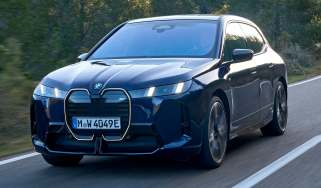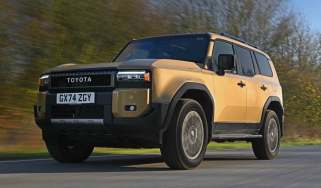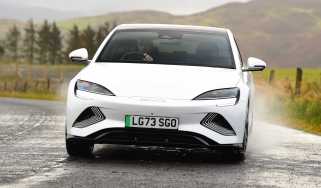Mercedes G-Class - Engines, performance and drive
The Mercedes G-Class is a formidable off-roader, but this does compromise its on-road handling versus its rivals

Obviously, the Mercedes G-Class is still awesome to drive off-road. The clientele may have changed, but any G-Class has to be able to tackle the roughest of roads and the toughest of challenges. There are three differential locks, a set of low-range gears for off-roading, and a G-Mode, which allows the car to creep slowly but steadily over rough ground. There’s also an additional 10cm of wading depth – now up to 70cm – when driving through water or mud. Some concessions to modernity have had to be made, though. Owing to tweaks to the internal friction of the engine line-up, Mercedes has added hill-descent control to the G-Class, because the engine braking in low range is reduced over the outgoing model.
Improvements have been made to the refinement of the G-Class while driving on the road, making it easier to live with than its predecessor. A nine-speed automatic transmission delivers smooth up and downshifts when left to its own devices, but some extra control is available via the weighty paddle shifts mounted behind the steering wheel.
This isn’t the sort of car you’d want to start pushing on a country road, though, because it doesn’t handle anywhere near as sharply as some of the best large SUVs around.
| Model | Power | 0-62mph | Top speed |
| G-Class G 500 | 443bhp | 5.4 seconds | 130mph |
| Mercedes-AMG G 63 4MATIC | 577bhp | 4.4 seconds | 137mph (149mph with AMG Driver’s pack) |
| G-Class G 450 d | 362bhp | 5.8 seconds | 130mph |
| G-Class G 580 with EQ technology | 579bhp | 4.7 seconds | 112mph |
What is the Mercedes G-Class like to drive?
In town
Even though the G-Class was originally designed to conquer harsh and inhospitable environments far from the beaten path, modern customers have taken to using the Mercedes as a status symbol in busy towns and cities.
Used - available now

2024 Mercedes
G Class
20,200 milesAutomaticPetrol4.0L
Cash £132,995
2014 Mercedes
G Class
69,791 milesAutomaticPetrol5.5L
Cash £54,995
2024 Mercedes
G Class
43,071 milesAutomaticPetrol4.0L
Cash £129,995
2023 Mercedes
G Class
18,850 milesAutomaticPetrol4.0L
Cash £158,995In fairness to the G-Class, its commanding driving position provides a great view over other traffic, while its square bonnet and chunky indicators make judging the car’s forward extremities fairly easy. You’ll still rely on the standard-fit 360-degree camera system when slotting into a space, because it has some chunky wheelarch extensions that stick out of the sides, and the spare tyre on the tailgate can cause issues when parking.
Speaking of parking, the G-Class isn’t the easiest vehicle to manoeuvre in tight spaces due to its size and huge 13.6-metre turning circle.
On A and B-roads
Using all the G-Class’s new-found performance needs plenty of forward planning when you’ve escaped the urban jungle, because things become a little more tense when you approach a corner. With so much mass to stop and turn, braking and cornering are two areas in which the Mercedes does not excel – its old-school construction means that even beside similarly vast SUVs, it’s still on the ponderous side.
The steering is nowhere near as sloppy as the Ineos Grenadier, but it’s slow and vague compared with the set-up you’ll find in a Range Rover, so a considered approach is required. The stability control’s tight-fisted grip on proceedings will be welcome to drivers who get a bit too carried away.
The sluggish handling doesn’t bring a benefit in comfort, either. A Range Rover, a Land Rover Defender or a Bentley Bentayga are all much more comfortable places to spend time behind the wheel.
On the motorway
On a motorway journey, the aerodynamic improvements of the G-Class, along with new insulation materials used in the A-pillars and elsewhere, have resulted in “increased acoustic comfort”, according to Mercedes. There’s no getting away from that chunky shape, though, so wind noise is still fairly pronounced at 70mph.
0-62mph acceleration and top speed
The top-of-the-range G 63 is powered by a fabulous 4.0-litre twin-turbocharged engine, which develops 577bhp and 850Nm of torque to create one of the most unlikely performance vehicles of the modern age. This is a little like strapping a pair of rockets to your favourite upmarket farm shop, with the 0-62mph time polished off in a ridiculous 4.4 seconds and a top speed of 137mph - although this can be increased to 149mph if you fit the optional AMG Driver’s pack. But while the speed is impressive, it’s the sound coming out of the side exhausts that’ll live longest in the memory.
In comparison, the 362bhp 3.0-litre straight-six diesel in the G 450 d is a more cultured and civilised affair, but it’s certainly no slouch. It’ll sprint from 0-62mph in 5.8 seconds before hitting a top speed of 130mph. As with the G 500 petrol, the G 450 d includes mild-hybrid technology, which uses a 48-volt integrated starter generator system that allows the engine to switch on and off seamlessly when stopping and moving away, while offering an extra 20bhp electrical boost to improve responsiveness.
The G 500 petrol uses a 3.0-litre straight-six turbocharged petrol engine, which, combined with the e-motor, puts out 443bhp and 560Nm of torque. Those are big numbers, so despite having to move around a 2,665kg kerbweight, the G 500 will still deliver acceleration that can surprise many hot hatchback drivers. The engine is fantastic; smooth and peaceful in everyday driving, yet even quite tuneful when you want to extend its legs.
Meanwhile, the fully electric G 580 EQ achieves the 0-62mph benchmark sprint 0.7 seconds quicker than the G 500, at 4.7 seconds, and has a top speed of 112mph.











